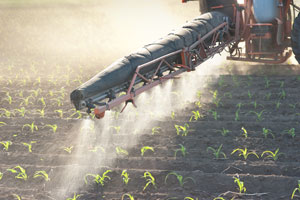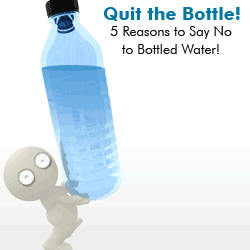Nitrates and nitrites are families of chemical compounds containing atoms of nitrogen and oxygen. Occurring naturally, nitrates and nitrites are critical to the continuation of life on the earth, since they are one of the main sources from which plants obtain the element nitrogen. This element is required for the production of amino acids, which, in turn, are used in the manufacture of proteins in both plants and animals. Phosphorus is essential to the growth of biological organisms, including both their metabolic and photosynthetic processes. Phosphorus occurs naturally in bodies of water mainly in the form of phosphate (i.e., a compound of phosphorus and oxygen).
However, being friends of agriculture, nitrate is not so friendly to water supplies.

One of the great transformations of agriculture over the past century has been the expanded use of synthetic chemical fertilizers. Ammonium nitrate is one of the most important of these fertilizers. In recent years, this compound has ranked in the top fifteen among synthetic chemicals produced in the United States. The increased use of nitrates as fertilizer has led to some serious environmental problems. All nitrates are soluble, so whatever amount is not taken up by plants in a field is washed away into groundwater and, eventually, into rivers, streams, ponds, and lakes. In these bodies of water, the nitrates become sources of food for algae and other plant life, resulting in the formation of algal blooms. Such blooms are usually the first step in the eutrophication of a pond or lake.
As a result of eutrophication, a pond or lake slowly evolves into a marsh or swamp, then into a bog, and finally into a meadow. Nitrates and nitrites present a second, quite different kind of environmental issue. These compounds have long been used in the preservation of red meats. They are attractive to the industry not only because they protect the meat from spoiling, but also because they give meat the bright red color that consumers expect. The use of nitrates and nitrites in meats has been the subject of controversy, however, for at least twenty years. Some critics argue that the compounds are not really effective as preservatives. They claim that preservation is really affected by the table salt that is usually used along with nitrates and nitrites. Furthermore, some scientists believe that nitrates and nitrites may themselves be carcinogens or may be converted in the body into a class of compounds known as nitrosamines, compounds that are known to be carcinogens.

In the 1970s, the Food and Drug Administration (FDA) responded to these concerns by dramatically cutting back on the quantity of nitrates and nitrites that could be added to foods. By 1981, however, a thorough study of the issue by the National Academy of Sciences showed that nitrates and nitrites are only a minor source of nitrosamine compared to smoking, drinking water, cosmetics, and industrial chemicals. Based on this study, the FDA finally decided in January 1983 that nitrates and nitrites are safe to use in foods. The addition of phosphates through the activities of humans can accelerate the eutrophication process of nutrient enrichment that results in accelerated ecological aging of lakes and streams. Phosphorus, especially in inland waters, is often the nutrient that limits growth of aquatic plants. Thus when it is added to a body of water, it may result in increased plant growth that gradually fills in the lake. Critical levels of phosphorus in water, above which eutrophication is likely to be triggered, are approximately 0.03 mg/l of dissolved phosphorus and 0.1 mg/l of total phosphorus. The discharge of raw or treated wastewater, agricultural drainage, or certain industrial wastes that contain phosphates to a surface water body may result in a highly eutrophic state, in which the growth of photosynthetic aquatic micro- and macro organisms are stimulated to nuisance levels.
Aquatic plants and mats of algal scum may cover the surface of the water. As these algal mats and aquatic plants die, they sink to the bottom, where their decomposition by microorganisms uses most of the oxygen dissolved in the water. The decrease in oxygen severely inhibits the growth of many aquatic organisms, especially more desirable fish (e.g., recreational catch fish such as trout) and in extreme cases may lead to massive fish kills. Excessive input of phosphorus can change clear, oxygen-rich, good-tasting water into cloudy, oxygen-poor, foul smelling, and possibly toxic water. Therefore, control of the amount of phosphates entering surface waters from domestic and industrial waste discharges, natural runoff, and erosion may be required to prevent eutrophication. Rocks may contain phosphates; those with calcium phosphate upon heat treatment with sulfuric acid serve as a source of fertilizers.
Phosphates, in addition to those found in fertilizers, are also present in such consumer products as detergent, baking powders, toothpastes, cured meats, evaporated milk, soft drinks, processed cheeses, pharmaceuticals, and water softeners. Phosphates are classified as orthophosphates (PO -3 4 , HPO -2, H 4 2PO4 , and H3PO4); condensed phosphates, or polyphosphates, which are molecules with two or more phosphorus atoms, oxygen atoms and in some cases, hydrogen atoms, combined in a complex molecule; and organically-bound phosphates. Orthophosphates in an aqueous solution can be used for biological metabolism without further breakdown. Orthophosphates applied to agricultural or residential cultivated land as fertilizers may be carried into surface waters with storm runoff and melting snow. Polyphosphates can be added to water when it is used for laundering or cleaning, for polyphosphates are present as builders of some commercial cleaning preparations for the public health sector. Massive algal blooms in lakes and floating foam on rivers aroused alarm in the United States in the 1970s.


After it was shown that phosphates from detergents were a key factor, legislation banning the use of phosphates in-home laundry detergents were passed in many areas. Phosphate legislation usually includes exemptions for products such as hard-surface cleaner and automatic dishwashing detergents used in the public health sector. Polyphosphates may also be added to water supplies during culinary water treatment and during the treatment of boiler water. Polyphosphates slowly undergo hydrolysis in aqueous solutions and are converted to orthophosphate forms. Organic phosphates are formed primarily by biological processes. They enter sewage water through body wastes and food residues. They may also be formed from orthophosphates in biological treatment processes and by receiving water organisms. Like polyphosphates, they are biologically transformed back to orthophosphates. One means of surface water protection from phosphorus addition in both domestic and industrial wastewaters is the use of phosphorus removal processes in wastewater treatment.
Phosphates are typically present in raw wastewaters at concentrations near 10 mg/l as P. During wastewater treatment, about 10-30% of the phosphates in raw wastewater is utilized during secondary biological treatment for microbial cell synthesis and energy transport. Additional removal is required to achieve low effluent concentration levels from the wastewater treatment process. Effluent limits usually range from 0.1-2 mg/l as P, with many established at 1.0 mg/l. Removal processes for phosphates from wastewaters utilize incorporation into suspended solids and the subsequent removal of those solids. Phosphates can be incorporated into chemical precipitates that are insoluble or of low solubility or into biological solids, (e.g, microorganisms). Chemical precipitation is accomplished by the addition of metal salts or lime, with polymers often used as flocculant aids.
The precipitation of phosphates from wastewater can occur during different phases of the wastewater treatment process. Pre-precipitation, where the chemicals are added to raw wastewater in primary sedimentation facilities, removes the precipitated phosphates with the primary sludge. In co-precipitation, the chemicals are added during secondary treatment to the effluent from the primary sedimentation facilities; to the mixed liquor in the activated-sludge process; or to the effluent from a biological treatment process before secondary sedimentation. They are removed with the waste biological sludge. In post-precipitation, the chemicals are added to the effluent from secondary sedimentation facilities and are removed in separate sedimentation facilities or in effluent filters.



